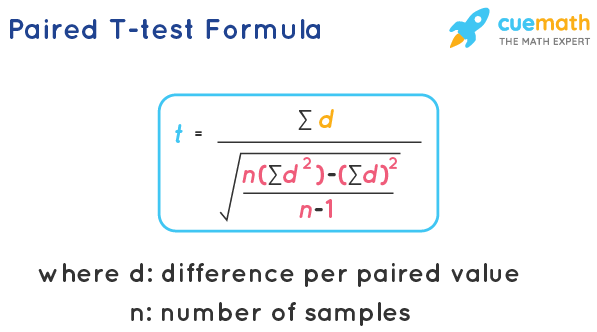
In Statistics, a t-test can be represented as a statistical hypothesis test where the test statistic supports a student’s t distribution if the null hypothesis is established. In Paired T-Test, they compare the means of two groups of observations. The observations must be randomly assigned to each of the two groups so that the difference in response seen is due to the treatment and not because of any other factors. If two samples are given, then the observation of one sample can be paired with the observation of the other sample, by using the paired t-test.
Further, this test can be used in making observations on the same sample before and after an event. Now, let us discuss what is paired t-test, its formula, table, and the procedure to perform the paired t-test in detail.
| 1. | Paired T-Test Definition |
| 2. | Paired T-Test Formula |
| 3. | Paired T-Test Table |
| 4. | Paired Vs Unpaired T-Test |
| 5. | Solved Examples on Paired T-Test |
| 6. | Practice Questions on Paired T-Test |
| 7. | FAQs on Paired T-Test |
The paired t-test gives a hypothesis examination of the difference between population means for a set of random samples whose variations are almost normally distributed. Subjects are often tested in a before-after situation or with subjects as alike as possible. The paired t-test is a test that the differences between the two observations are zero.
Let us assume two paired sets, such as Xi and Yi for i = 1, 2, …, n such that their paired difference is independent which is identically and normally distributed. Then the paired t-test concludes whether they notably vary from each other.
Paired T-test is a test that is based on the differences between the values of a single pair, that is one deducted from the other. In the formula for a paired t-test, this difference is notated as d. The formula of the paired t-test is defined as the sum of the differences of each pair divided by the square root of n times the sum of the differences squared minus the sum of the squared differences, overall n-1.
The formula for the paired t-test is given by

Paired T-test table enables the t-value from a t-test to be converted to a statement about significance. The table is given below:
\(\begin
\text < Paired T Test Table >\\
\begin<|c|c|c|c|c|c|c|>
\hline > \\
\hline \begin
\text < Degrees of >\\
\text < fredom >(n-1)
\end & \alpha=0.20 & 0.10 & 0.05 & 0.02 & 0.01 & 0.002 \\
\hline & & & & & & \\
\hline 1 & 3.078 & 6.314 & 12.706 & 31.821 & 63.657 & 318.300 \\
\hline 2 & 1.886 & 2.920 & 4.303 & 6.965 & 9.925 & 22.327 \\
\hline 3 & 1.638 & 2.353 & 3.182 & 4.541 & 5.841 & 10.214 \\
\hline 4 & 1.533 & 2.132 & 2.776 & 3.747 & 4.604 & 7.173 \\
\hline 5 & 1.476 & 2.015 & 2.571 & 3.305 & 4.032 & 5.893 \\
\hline 6 & 1.440 & 1.943 & 2.447 & 3.143 & 3.707 & 5.208 \\
\hline 7 & 1.415 & 1.895 & 2.365 & 2.998 & 3.499 & 4.785 \\
\hline 8 & 1.397 & 1.860 & 2.306 & 2.896 & 3.355 & 4.501 \\
\hline 9 & 1.383 & 1.833 & 2.262 & 2.821 & 3.250 & 4.297 \\
\hline 10 & 1.372 & 1.812 & 2.228 & 2.764 & 3.169 & 4.144 \\
\hline 11 & 1.363 & 1.796 & 2.201 & 2.718 & 3.106 & 4.025 \\
\hline 12 & 1.356 & 1.782 & 2.179 & 2.681 & 3.055 & 3.930 \\
\hline 13 & 1.350 & 1.771 & 2.160 & 2.650 & 3.012 & 3.852 \\
\hline 14 & 1.345 & 1.761 & 2.145 & 2.624 & 2.977 & 3.787 \\
\hline 15 & 1.341 & 1.753 & 2.131 & 2.602 & 2.947 & 3.733 \\
\hline
\end
\end\)
The similarity between paired and unpaired t-test is that both assume data from the normal distribution.
Characteristics of Unpaired T-Test:
Characteristics of Paired T-Test:
Let us take two sets of data that are related to each other, say X and Y with xi ∈ X, yi ∈ Y. where i = 1, 2,……., n. Follow the steps given below to find the paired t-test.
Important Notes on Paired T-Test
Here are a few important notes on the Paired T-Test:
Related Topics
Example 1: What conclusion should be made with respect to an experiment when the significance level is 0.068? Solution: Since the p-value of 0.068 is greater than α = 0.05, it would fail to reject the null hypothesis. Answer: As the value of p < 0.05, the null hypothesis is rejected.
Example 2: In which of the following cases could you use a paired-samples t-test? (a) When comparing the same participant's performance before and after training
(b) When comparing two separate groups of people Solution: A T-test can be used in making observations on the same sample before and after an event. In option (b) the data does not involve observations before and after an event for the same set of people. Answer: a. When comparing the same participant's performance before and after training

Math will no longer be a tough subject, especially when you understand the concepts through visualizations.